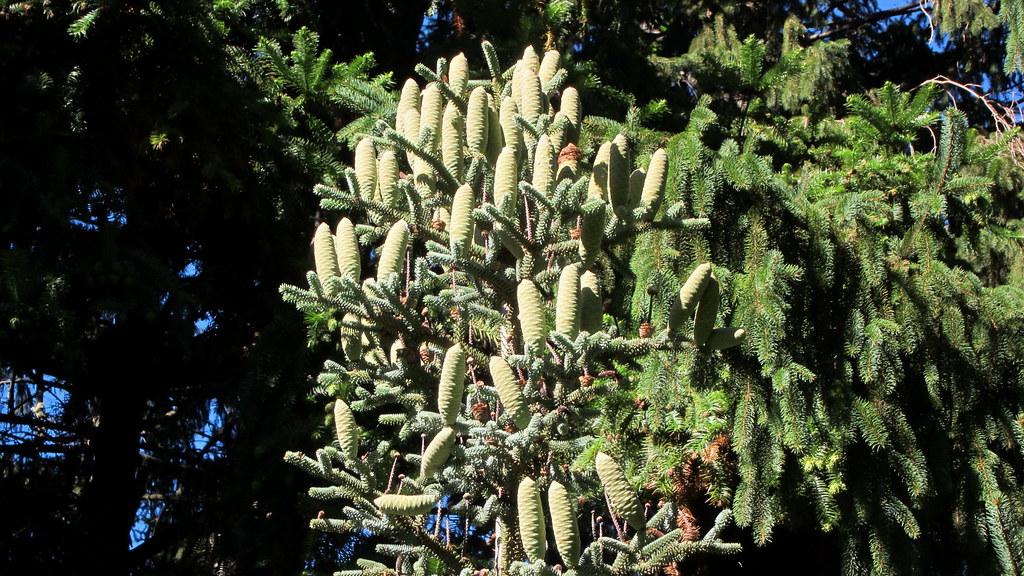

Blue Spanish Fir (Abies pinsapo ‘Glauca’)
Also known as: Abies pinsapo 'Glauca', Glaucous Spanish Fir.
The Blue Spanish Fir (Abies pinsapo ‘Glauca’) is an evergreen tree that is native to the mountains of southern Spain. Its beautiful blue needle-like foliage and pyramidal shape set it apart from other coniferous trees. This tree is an extremely hardy species, and can survive temperatures as low as -20 Fahrenheit. It is also incredibly drought tolerant, but will thrive with regular watering in the summer. Its striking blue color makes it the perfect accent to any landscaping design, adding a pop of color to your garden. It is also surprisingly fast-growing, making it ideal for creating a privacy screen quickly. All in all, the Blue Spanish Fir is an amazing plant that can bring year-round beauty to any garden!
Interesting facts about the Blue Spanish Fir:
- Striking Blue-Green Foliage: The most distinguishing feature of the Blue Spanish Fir is its striking blue-green needles. This distinctive coloration makes it a popular choice for ornamental landscaping, providing a visually appealing contrast to the typical greens of most garden foliage.
- Dense and Symmetrical Growth: This fir cultivar is known for its dense, symmetrical growth habit, forming a conical shape that is both neat and compact. This characteristic makes it an excellent choice for formal garden settings or as a focal point in landscape design.
- Origin and Rarity: The Blue Spanish Fir is a cultivar of Abies pinsapo, which is native to the mountains of southern Spain and northern Morocco. The ‘Glauca’ variety, with its blue-tinged needles, is less common and highly prized for its unique appearance.
- Slow Growth Rate: Like many fir species, the Blue Spanish Fir grows slowly, which makes it suitable for use in smaller gardens where space is limited. Its slow growth also means it requires less pruning and maintenance.
- Adaptation to Diverse Climates: The Blue Spanish Fir is adaptable to a wide range of climates and is noted for its tolerance to both cold and heat. This makes it a versatile choice for many different garden environments.
- Resilience to Pests and Diseases: This fir species shows a good degree of resistance to pests and diseases, which adds to its appeal as a low-maintenance landscaping option. It’s particularly resistant to the fungal diseases that can affect many other types of conifers.
- Cone Production: The Blue Spanish Fir produces large, upright cones that are quite striking in appearance. The cones can add an additional ornamental element to the tree, especially when they stand out against the blue-green foliage.
Plant care guide:
Watering
Blue Spanish Fir should be watered once a week during the growing season (April - October in most locations). During this time, the plant should be watered deeply with about 1-2 inches of water each time. During the winter months (November - March), water whenever the soil feels dry to the touch. For maximum success, water your Blue Spanish Fir with filtered or rainwater whenever possible.
Sunlight
Blue Spanish Fir trees prefer full sun, although they can tolerate light shade. For optimal growth, your Blue Spanish Fir should receive about 5 to 6 hours of direct sunlight per day as a minimum. The best time to provide sunlight for your Blue Spanish Fir is during the morning and afternoon, so it can benefit from the sun's warmth and intense light. Avoid exposing your Blue Spanish Fir to direct sunlight during the peak of the day from 10am to 2pm, as this can cause sunburn or heat stress to the tree.
Pruning
Blue Spanish Fir plants should be pruned twice per year, once in early spring and once in mid-summer. Pruning in early spring should focus on removing diseased or damaged branches, as well as any crossing branches that may interfere with the plant's growth or shape. In mid-summer, pruning should focus on thinning out the canopy in order to promote new growth and encourage a full, symmetrical shape. When pruning, make sure to make cuts just above a healthy bud, angled away from the bud, and be sure to prune no more than a third of the total branch or foliage.
Plant information:
- Family: Pinaceae
- Type: Tree
- Height: ~13.72 meters
- Cycle: Perennial
- Growth Rate: Low
-
Anatomy:
- Cones: green, light-green
- Leaves: dark-green
- Stems: brown
- Branches: brown
- Twigs: brown
- Flower Color: Non-flowering
- Maintenance: Moderate
- Care Level: Medium
-
Watering:
- ~5 cm
- Average
- Every 7-10 days
- Sunlight requirement: Full sun, part shade
- Pruning:
- March, April, June, July, August, March, April, May, June, July, August
- 2 times yearly
- Propagation: Cutting, Grafting Propagation, Layering Propagation, Seed Propagation
- Origin: Southern Spain
- Seeds: No
- Drought Tolerant: Yes
- Salt Tolerant: Yes
- Thorny: No
- Invasive: No
- Tropical: No
- Indoor: No
- Flowers: Yes
- Cones: Yes
- Fruits: No
- Edible Fruit: No
- Leaf: Yes
- Edible Leaf: No
- Cuisine: No
- Medicinal: No
- Poisonous to Humans: No
- Poisonous to Pets: No

Sources & more information:
Content is based on public databases such as the KEW Plants of the World database, among others. Please double-check all information. "About Plants" does not take responsibility for any inaccuracies.
